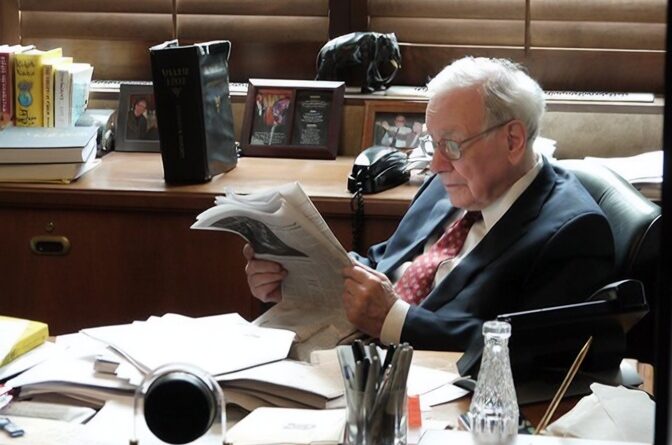Warren Buffett’s 8 Timeless Secrets to Staying Calm in Volatile Markets – And How to Apply Them Today
Warren Buffett, the legendary investor and CEO of Berkshire Hathaway, has long been admired for his unflappable demeanor amid market chaos. With decades of experience navigating booms and busts, Buffett’s approach to volatile markets offers invaluable lessons for everyday investors. His secrets aren’t about quick fixes but building a mindset that withstands fear and greed. In this article, we’ll explore eight of his key principles and how you can integrate them into your financial strategy for long-term success.
Table of Contents
- Understanding Warren Buffett’s Philosophy on Market Volatility
- Secret 1: Embrace Long-Term Thinking Over Short-Term Noise
- Secret 2: Focus on Intrinsic Value, Not Market Prices
- Secrets 3-5: Diversification, Patience, and Emotional Discipline
- Applying Buffett’s Secrets: Practical Steps for Your Portfolio
- Conclusion: Building Your Calm Investing Mindset
Understanding Warren Buffett’s Philosophy on Market Volatility
Warren Buffett’s investment philosophy is rooted in value investing, a strategy pioneered by his mentor Benjamin Graham. He views market volatility not as a threat but as an opportunity. During turbulent times, like the 2008 financial crisis or the 2020 pandemic crash, Buffett stayed the course, often buying when others panicked.
This mindset stems from his belief that the stock market is a mechanism for transferring money from the impatient to the patient. Buffett famously said, “Be fearful when others are greedy, and greedy when others are fearful.” This contrarian approach helps him remain calm because he focuses on fundamentals rather than fleeting news cycles.
For individual investors, adopting this philosophy means tuning out daily fluctuations. Instead, assess your investments based on their underlying business strength. This shift reduces anxiety and positions you for compounded growth over time.
Buffett’s annual letters to shareholders reveal his calm rationale. He emphasizes that short-term market movements are unpredictable, but great companies endure. By studying these letters, you can internalize his serene perspective on volatility.
Secret 1: Embrace Long-Term Thinking Over Short-Term Noise
One of Warren Buffett’s core secrets to staying calm is prioritizing long-term horizons. He advises investors to imagine holding stocks for 10 years or more before buying. This perspective filters out the noise of daily market swings, which often stem from temporary events like earnings reports or geopolitical tensions.
In volatile markets, short-term traders react impulsively, leading to losses. Buffett, however, views his portfolio as a collection of businesses, not ticker symbols. This mental framework allows him to sleep soundly during downturns, knowing his investments align with enduring value.
To apply this, review your investment goals. Are you in it for quick gains or sustainable wealth? Shifting to a long-term view can transform volatility from a stressor into a buying opportunity. For beginners, starting with saving vs investing strategies in 2025 can build this foundation.
Historical data supports this: The S&P 500 has delivered average annual returns of about 10% over decades, despite periodic crashes. By ignoring short-term dips, investors like Buffett capture these gains.
Secret 2: Focus on Intrinsic Value, Not Market Prices
Warren Buffett stresses calculating a company’s intrinsic value – its true worth based on future cash flows and competitive advantages. Market prices, influenced by sentiment, often deviate from this value during volatility. By anchoring decisions to intrinsic value, he avoids panic selling when prices plummet.
For instance, during the dot-com bubble burst, Buffett avoided overvalued tech stocks, preserving capital. Today, in an era of meme stocks and crypto hype, this secret remains relevant. It promotes calm by reminding investors that temporary price drops don’t alter a solid business’s potential.
Practical application involves basic valuation tools like discounted cash flow analysis. While complex, resources like SEC investor education guides simplify the process. Start by evaluating familiar companies, assessing their moats – sustainable edges like brand strength or cost advantages.
This focus builds confidence. When markets tumble, you’ll know if your holdings are undervalued bargains, echoing Buffett’s opportunistic buys in past crises.
Secrets 3-5: Diversification, Patience, and Emotional Discipline
Secret 3: Diversification is Buffett’s subtle yet powerful tool for calm. Though he concentrates bets on high-conviction ideas, he advises broad indexing for most investors. This spreads risk, cushioning portfolio blows from any single event.
In volatile times, a diversified mix of stocks, bonds, and perhaps real estate prevents overreaction. Buffett recommends low-cost S&P 500 index funds for this purpose, noting they’ve outperformed most active managers over time.
Secret 4: Patience is the antidote to FOMO (fear of missing out) and panic. Buffett waits for “fat pitches” – ideal buying opportunities. During market frenzy, he sits on cash, ready to deploy when prices crash. This discipline avoids costly mistakes driven by emotion.
Secret 5: Emotional discipline involves ignoring herd mentality. Buffett reads voraciously but tunes out cable news hype. He cultivates rationality through routines like journaling investment theses, helping maintain composure when volatility spikes.
These secrets interconnect: Diversification provides safety nets, patience allows value to emerge, and discipline keeps emotions in check. For more on building resilience, explore emergency fund essentials to weather market storms.
Implementing them requires practice. Track your reactions during minor dips to build habits. Over time, this trio fosters the calm Buffett embodies.
Applying Buffett’s Secrets: Practical Steps for Your Portfolio
Now, let’s translate Warren Buffett’s secrets into actionable steps. Begin with portfolio assessment: List your holdings and evaluate their intrinsic values. If they’re strong businesses bought at fair prices, volatility becomes less daunting.
Next, adopt dollar-cost averaging – investing fixed amounts regularly, regardless of market levels. This mirrors Buffett’s patience, averaging costs over time and reducing timing risks. It’s ideal for retirement accounts like 401(k)s.
For diversification, allocate across asset classes. Aim for 60-70% equities in index funds, 20-30% bonds, and the rest in cash or alternatives. Adjust based on your risk tolerance, a key factor in staying calm.
Build emotional buffers: Set rules like a 20% stop-loss only for speculative positions, not core holdings. Regularly review stock market basics to reinforce knowledge, curbing fear.
In 2025, with potential rate cuts and economic shifts, these applications are timely. Buffett’s secrets help navigate uncertainties, from inflation to recessions, ensuring steady progress toward financial goals.
Consider tax efficiency too: Hold investments long-term to benefit from lower capital gains rates, aligning with Buffett’s buy-and-hold ethos. Tools like brokerage apps simplify tracking, making application accessible.
Finally, educate yourself continuously. Buffett spends hours reading daily; emulate this by following reputable sources. This knowledge base solidifies calm, turning volatility into advantage.

Conclusion: Building Your Calm Investing Mindset
Warren Buffett’s secrets to staying calm in volatile markets revolve around timeless principles: long-term vision, value focus, diversification, patience, and emotional control. By applying these, you can transform market turbulence from a foe into a friend, fostering wealth and peace of mind.
Start small – review one secret today and implement it. Over time, this mindset shift will yield compounding benefits, much like Buffett’s Berkshire Hathaway empire. Remember, investing success is 80% behavior; master your emotions to join the ranks of calm, prosperous investors.
For further reading, delve into Buffett’s shareholder letters or books like “The Intelligent Investor.” In an unpredictable world, his wisdom remains a beacon for navigating volatility with grace.




